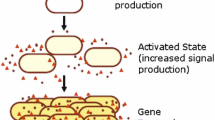Abstract
The bacteria Pseudomonas aeruginosa use the size and density of their colonies to regulate the production of a large variety of substances, including toxins. This phenomenon, called quorum sensing, apparently enables colonies to grow to sufficient size undetected by the immune system of the host organism.
In this paper, we present a mathematical model of quorum sensing in P. aeruginosa that is based on the known biochemistry of regulation of the autoinducer that is crucial to this signalling mechanism. Using this model we show that quorum sensing works because of a biochemical switch between two stable steady solutions, one with low levels of autoinducer and one with high levels of autoinducer.
Similar content being viewed by others
References
Anderson, J. B., C. Sternberg, L. K. Poulsen, M. Givskov and S. Molin (1998). New unstable variants of green fluorescent protein for studies of transient gene expression in bacteria. Appl. Environ. Microbiol. 64, 2240–2246.
Chalfie, M., Y. Tu, G. Euskirchen, W. W. Ward and D. C. Prasher (1994). Green fluorescent protein as a marker for gene expression. Science 263, 802–805.
Characklis, W. G. and K. C. Marshall (1990). Biofilms, New York: John Wiley & Sons, Inc.
Davies, D. G., M. R. Parsek, J. P. Pearson, B. H. Iglewski, J. W. Costerton and E. P. Greenberg (1998). The involvement of cell-to-cell signals in the development of bacterial biofilm. Science 280, 295–298.
Ehrenberg, M. and A. Sverredal (1995). A model for copy number control of the plasmid R1. J. Mol. Biol. 246, 472–485.
Fuqua, C., S. C. Winans and E. P. Greenberg (1996). Census and concensus in bacterial ecosystems: The luxR-luxI family of quorum-sensing transcriptional regulators. Annu. Rev. Microbiol. 50, 727–751.
Govan, J. R. and V. Deretic (1996). Microbial pathogenesis in cystic fibrosis: mucoid pseudomonas aeruginosa and Burkolderia cepacia. Microbiol. Rev 60, 539–574.
James, S., P. Nilsson, G. James, S. Kjelleberg and T. Fagerström (2000). Luminescence control in the marine bacterium Vibrio fischeri: An analysis of the dynamics of lux regulation. J. Mol. Biol. 296, 1127–1137.
Pearson, J. P., C. Van Delden and B. H. Iglewski (1999). Active efflux and diffusion are involved in transport of Pseudomonas aeruginosa cell-to-cell signals. J. Bacteriol. 181(4), 1203–1210.
Van Delden, C. and B. H. Iglewski (1998). Cell-to-cell signaling and Pseudomonas aeruginosa infections. Emerging Infect. Dis. 4, 551–560.
Ward, J. P., J. R. King and A. J. Koerber (2000). Mathematical modelling of quorum sensing in bacteria. Preprint.
Weinberger, H. F. (1983). A simple system with a continuum of stable inhomogeneous steady states, in Nonlinear Partial Differential Equations in Applied Science (Tokyo, 1982), Amsterdam: North-Holland, pp. 345–359.
Author information
Authors and Affiliations
Corresponding author
Rights and permissions
About this article
Cite this article
Dockery, J.D., Keener, J.P. A mathematical model for quorum sensing in Pseudomonas aeruginosa . Bull. Math. Biol. 63, 95–116 (2001). https://doi.org/10.1006/bulm.2000.0205
Received:
Accepted:
Issue Date:
DOI: https://doi.org/10.1006/bulm.2000.0205




